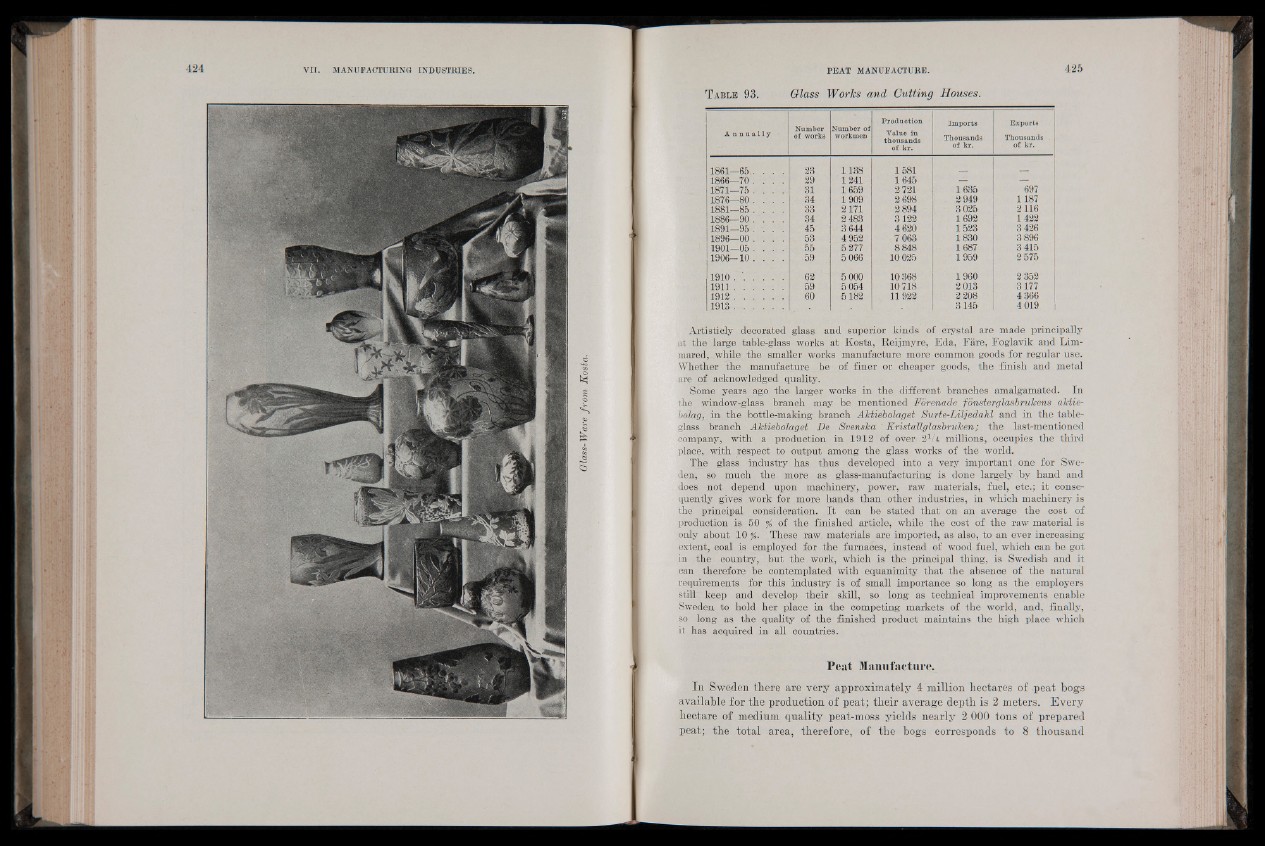
Glass-Ware from, Kosta.
Table 93. Glass Works and Cutting Houses.
A n n u a l l y
Number
of works
Number of
workmen
Production
Value in
thousands
of kr.
Imports
Thousands
of kr.
Exports
Thousands .
of kr.
1861—65............. 23 1138 1581
1866—70 . . . . 29 1241 1645 —
1871—75 . . . . 31 1659 2 721 1635 697
1876—80 . . . . 34 1909 2 698 2 949 1187
1881—85 . . . . 33 2171 2 894 3 025 2116
1886—90 . . . . 34 2 483 3122 1692 1422
1891—95 . . . . 45 3 644 4 620 1523 3 426
1896—00 . . . . 1 53 4 952 7063 1830 3896
1901—05 . . . . 55 5 277 8 848 1687 3 415
1906-10 . . , . 59 5 066 10 025 1959 2575
1910 ■ ................ 62 5 000 10 368 1960 2352
1911.................... 59 5 054 10 718 2 013 3177
1912.................... 60 5182 | 11922 2 208 4 366
1913.................... 3145 4 019
Artisticly decorated glass and superior, kinds of crystal are made principally
at the large table-glass works at Kosta, Reijmyre, Eda, Fare, Foglavik and Lim-
mared, while the smaller works manufacture more common goods for regular use.
Whether the manufacture be of finer or cheaper goods, the finish and metal
are of acknowledged quality.
Some years ago the larger works in the different branches amalgamated. In
the window-glass branch may be mentioned Forenade fonsterglasbrukens ahtie-
bolag, in the bottle-making branch Ahtiebolaget Surte-Liljedahl and in the table-
glass branch Aletiebolaget De Svenska Kristallglasbruken; the last-mentioned
company, with a production in 1912 of over 21 millions, occupies the third
place, with respect to output among the glass works of the world.
The glass industry has thus developed into a very important , one for Sweden,
so much the more as glass-manufacturing is done largely by hand and
does not depend upon machinery, power, raw materials, fuel, etc.; it consequently
gives work for more hands than other industries, in which machinery is
the principal consideration. It can be stated that on an average the cost of
production is 50 °/ of the finished article, while ..the cost of the raw material is
only about 10 %. These raw materials are imported, as also, to an ever increasing
extent, coal is employed for the furnaces, instead of wood fuel, which can be got
in the country, but the work, which is the principal thing, is Swedish and it
can therefore be contemplated with equanimity that the absence of the natural
requirements for this industry is of small importance so long as the employers
still keep and develop their skill, so long as technical improvements enable
Sweden to hold her place in the competing markets of the world, and, finally,
so long as the quality of the finished product maintains the high place which
it has acquired in all countries.
Peat Manufacture.
In Sweden there are very approximately 4 million hectares of peat bogs
available for the production of peat; their average depth is 2 meters. Every
hectare of medium quality peat-moss yields nearly 2 0 0 0 tons of prepared
peat; the total area, therefore, of the bogs corresponds to 8 thousand